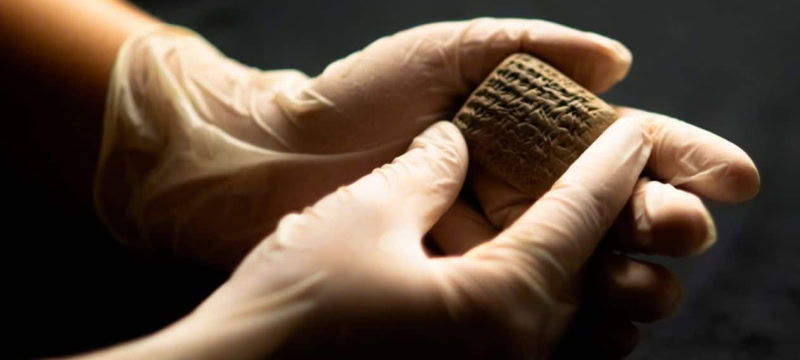Archaeologists have unearthed a Small Clay Tablet from the 15th century BC during excavations in Turkey, which may offer insights into life during the Late Bronze Age. The tablet, inscribed with Akkadian cuneiform, likely served as a detailed receipt for a large purchase of furniture.
Cuneiform, one of the earliest writing systems, was used throughout the ancient Middle East, including Mesopotamia, where it recorded languages such as Sumerian and Akkadian. The 28-gram tablet, measuring 1.7 by 1.4 inches, was discovered outside the gate of the ancient city Alalakh, now known as Tell Atchana.
Read more: Study Predicts that Global Cancer Deaths in Men Could Rise by 93% by 2050
Found in July amidst earthquake restoration efforts, this artifact represents a significant find for understanding the economic and administrative aspects of the period, according to Turkey’s Minister of Culture and Tourism, Mehmet Ersoy. Dr. Murat Akar, the excavation leader, noted that the discovery also symbolizes recovery and healing for the community affected by the disaster.
A Historical Furniture Purchase Record
In the 1930s, British archaeologist Sir Leonard Woolley first excavated the city of Alalakh, uncovering a collection of cuneiform tablets in a fortress near the gate, according to Dr. Jacob Lauinger, an associate professor of Assyriology at Johns Hopkins University.
The newly discovered tablet is thought to be from the same archive of tablets or another unexcavated one in the fortress, possibly washed down to the gate over time. Lauinger, along with Zeynep Türker, a doctoral student at Johns Hopkins, and Dr. Murat Akar from Mustafa Kemal University, are translating and analyzing the tablet.
Their preliminary translation reveals it documents the purchase of about 200 or more wooden tables, chairs, and stools. Although other tablets from Alalakh refer to furniture production, none match the scale of this new tablet’s records. The team is also exploring the tablet’s links to Woolley’s finds and other Late Bronze Age cuneiform records related to furniture.

Administrative texts like the newly found tablet from Alalakh documented the quantities of raw materials and finished goods produced, distributed, and used by palace workers.
These records offer valuable insights into the ancient society and economy of Alalakh, essentially giving us a glimpse into the bookkeeping of an ancient accountant from nearly 3,500 years ago, according to Lauinger.
The research team is also examining how this tablet fits into the broader context of the city’s society at the time. They suspect that the furniture was produced in a single period rather than in small, cumulative orders and are investigating various historical scenarios that could explain the large quantity of furniture, such as a royal event, a religious festival, or export purposes. The team aims to determine which scenarios are most likely based on their findings.
Preserving a Vanished City
After Sir Leonard Woolley’s excavations ended in the late 1940s, Tell Atchana was left to deteriorate for nearly a century, with nature reclaiming the site. By 2012, Akar and his team found the site in a fragile state, obscured by dense Syrian mesquite plants. Since 2019, they have worked diligently to protect and restore the ancient city’s mud-brick structures.
In February 2023, a series of earthquakes struck near Tell Atchana, including a 7.8-magnitude quake on February 6 that affected 11 cities in southeastern Turkey and northern Syria, followed by a 7.5-magnitude quake and a 6.3-magnitude quake with 40,000 aftershocks two weeks later. The disasters resulted in tens of thousands of casualties.

Several sections of the new excavation areas at Tell Atchana collapsed, and significant damage occurred to the large-scale exposures from Woolley’s earlier work. Despite this, the archaeological research compound remained intact and served as a humanitarian support center in the immediate aftermath of the earthquakes, according to a July study published in the Journal of Field Archaeology coauthored by Akar and his team.
After a few months, restoration and excavations resumed to aid students affected by the quake. The local community produced around 4,500 mud bricks during the 2023 field season to repair the damage. Akar noted that using archaeology for recovery and healing was crucial, providing both a means of livelihood for locals and preserving their cultural heritage.
The tablet was discovered during these new excavations. As the team continues their work, they hope to uncover more tablets from parts of the fortress previously unexcavated by Woolley. Lauinger remarked that finding cuneiform tablets is a rare and thrilling discovery for archaeologists.









